Spawning grounds of chub mackerel shifting northward due to ocean warming driven by climate change
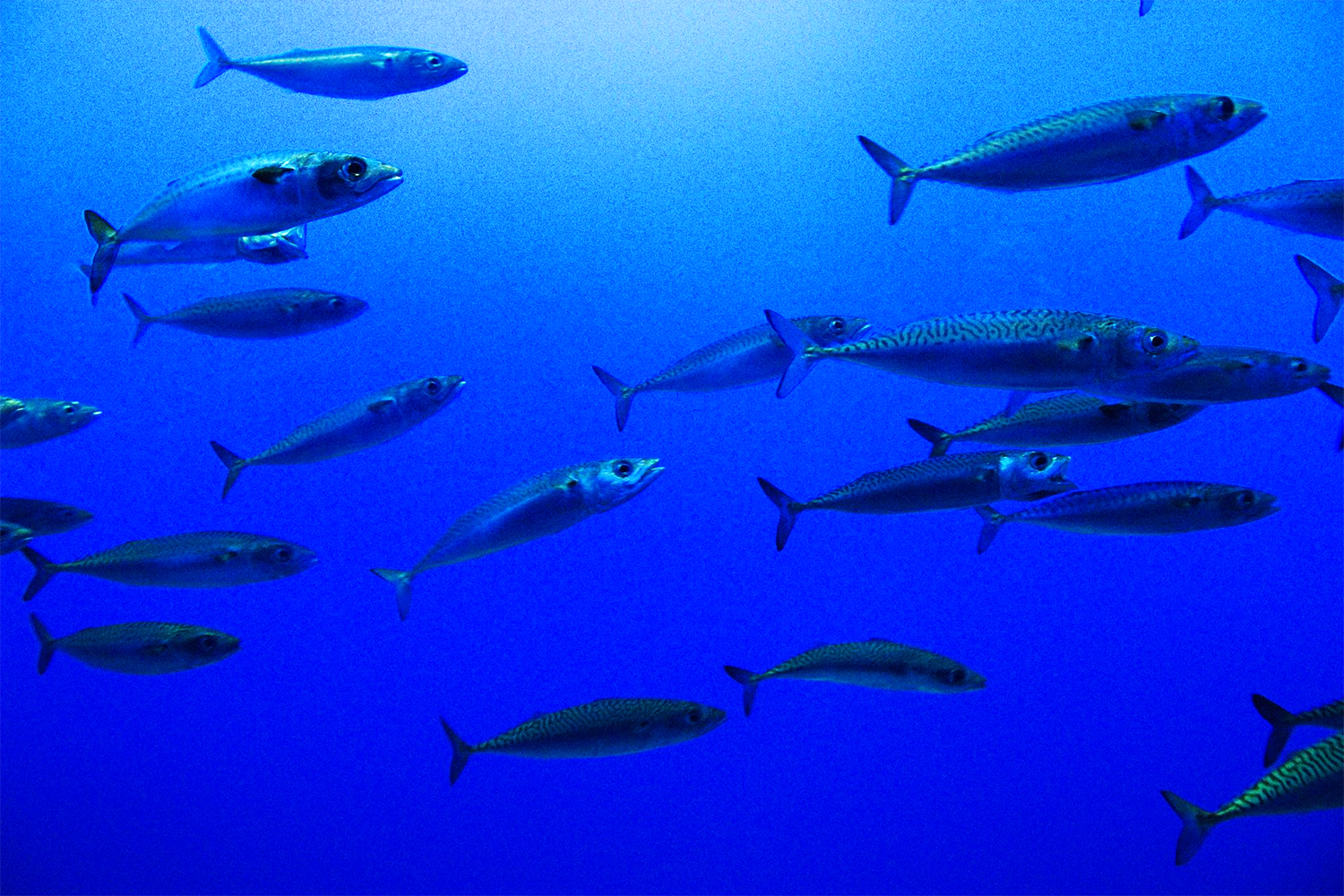
Chub mackerel (Scomber japonicus) are forage fish that play a crucial role in the transfer of energy within marine food webs, serving as the primary food source for various marine predators and feeding on zooplankton and phytoplankton. This species is widely distributed in the western North Pacific with two stocks, namely the Tsushima Warm Current (TWC) stock in the East China Sea (ECS), Yellow Sea (YS), and Japan/East Sea (JES), and the Pacific stock along the Pacific coast.
The TWC stock is an economically valuable fishery that is exploited by various countries, including China, Korea, and Japan. From February to June, the TWC stock spawns mainly in the ECS and Korea Strait (KS), after which it migrates to its northern feeding grounds in the JES and YS through the KS [6,11,12,13,14].
Variations in the environmental conditions of spawning grounds caused by climate change can cause changes in the physiochemistry of spawners and food availability during the early life stages of fish, and these alterations have implications for spawning behavior, growth, and survival rates, as well as for recruitment strength and fluctuations in the abundance of fish. Changes in the marine environment can result in shifts in spawning ground locations and conditions for chub mackerel, driving subsequent changes in the spatial distribution and survival of hatched eggs and larvae.
Spawning ground locations may shift due to climate change and subsequent variations in the marine environment, as chub mackerel must spawn under conditions that are both environmentally and geographically suitable. However, few studies have aimed to project shifts in the spawning grounds of chub mackerel driven by climate change.
This article – summarized from the original publication [Go, S. et al. 2025. Projecting the Shift of Chub Mackerel (Scomber japonicus) Spawning Grounds Driven by Climate Change in the Western North Pacific Ocean. Fishes 2025, 10(1), 20] – evaluated and projected the effects of climate-driven changes in ocean circulation and water temperature on the potential spawning ground of the TWC stock of chub mackerel.
Study setup
We developed spawning ground indices for chub mackerel and tested whether potential spawning grounds will shift under a climate change scenario published by the Intergovernmental Panel on Climate Change (IPCC). To identify potential spawning grounds, we estimated and projected water temperature and salinity at a depth of 10 m in the western North Pacific Ocean. We also derived water temperature and salinity for the 2010s (2010–2019) and 2050s (2050–2059) with an ocean circulation model based on a scenario of the IPCC Fifth Assessment Report (IPCC AR5).
To construct the regional ocean circulation model, we utilized the Regional Ocean Modeling System (ROMS). Additionally, this model incorporates detailed governing equations that address momentum, continuity, temperature, and salinity transport, allowing for a comprehensive representation of oceanic processes. The model’s accuracy has been validated through comparisons with observational data, ensuring reliable simulations that capture both large-scale and finer oceanic features.
The model was designed to simulate ocean conditions from 2010 to 2059 under climate change conditions based on the projections of IPCC AR5. In sum, this multi-layered approach combining global and regional data with atmospheric and tidal forces allowed us to simulate the complex oceanic conditions surrounding Korea with a high degree of precision, capturing both the broad effects of climate change and local ocean dynamics.
For detailed information on the data and modeling used, refer to the original publication.
Results and discussion
The spawning ground of the TWC stock has been reported to extend from the southern part of the ECS to the southwestern part of the JES. The spawning grounds previously reported by several researchers, along with our own results, suggest that the spawning grounds extend northward from the southern ECS in February to the southern JES in June, with possible extension to the waters off Vladivostok and Hokkaido after June.
Our model was used to estimate and project potential spawning grounds from February to June for both the 2010s and 2050s. Potential spawning grounds were projected to shift northward from the 2010s to 2050s, and these suggested that chub mackerel will spawn further north in the 2050s compared to the 2010s, which means that spawning will become less strongly influenced by the Kuroshio Current. This shift in spawning grounds will affect chub mackerel survival and growth during early life stages and in nursery grounds, as their weak swimming ability during the early life stages limits movement toward favorable habitat.
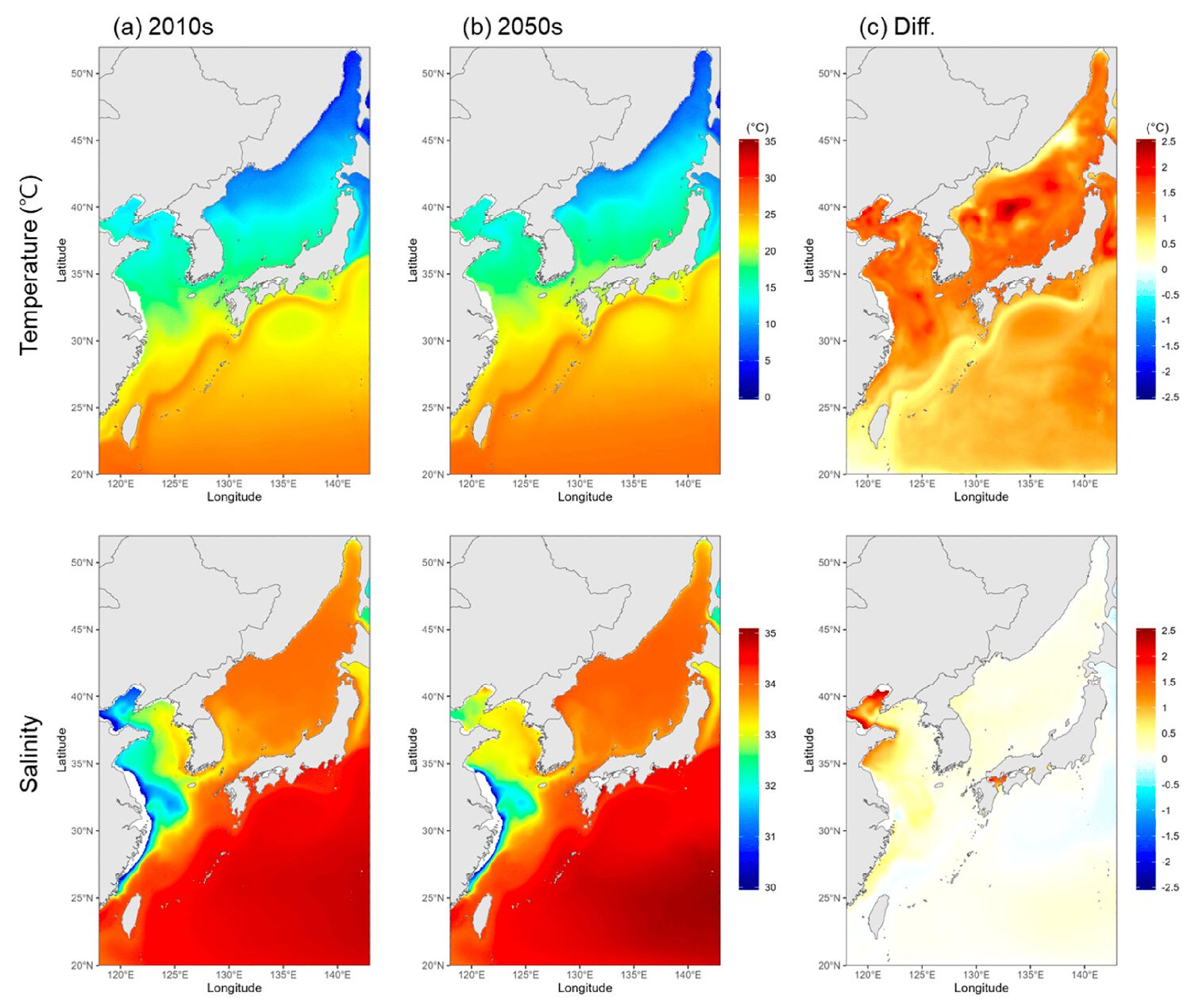
Li et al. proposed that the main nursery ground of the TWC stock would shift longitudinally westward from the Pacific side of Japan and the Japan/East Sea (JES) to the waters off Jeju Island if the spawning grounds shifted and the influence of the Kuroshio Current weakened. Therefore, we expect that the spawning grounds of the TWC stock will shift northward in the 2050s relative to the 2010s, resulting in a subsequent westward shift of the nursery grounds. Driven by these changes, the ratios of exploitable chub mackerel biomass and production will increase in the Korean Straits (KS) and the Yellow Sea (YS) relative to the JES.
Our spawning grounds data predicted spatiotemporal changes in the potential spawning ground of the TWC stock using the ROMS. Our model outcomes were generally compatible with previous observations and modeling studies in the region, and the differences were explainable. This compatibility suggests that our method can be applied to the estimation of potential spawning grounds for other stocks or species, provided that sufficient research is available on their spawning characteristics and the marine environment of the area.

Results diagnosed the regional ocean circulation model for the western North Pacific using two methods and found that, while the model results did not align well with observations in the same space and time, the overall trends were significantly similar. To improve the model’s accuracy, data assimilation methods should be applied in future studies.
Although it was assumed that the spawning period would not change, the main spawning period may shift due to the environmental changes, even at the same spawning location. For example, past studies have reported that photoperiod influences gonad development, suggesting that the spawning period may be influenced by changes in the annual photoperiod driven by climate change, and this possibility requires further exploration in the near future.
In this study, we calculated spawning grounds under the assumption that the spawning area of the TWC stock is located within the continental shelf areas of the ECS, YS and JES where depths are 50 to 300 meters. However, other researchers reported collecting chub mackerel larvae in Kagoshima Bay and Osumi Strait, which included shallow areas of <50 meters, suggesting that chub mackerel may spawn in shallow coastal areas. Results of this study demonstrate that the spawning grounds of chub mackerel could extend into the YS and northern JES.
To improve the reliability of the present study regarding chub mackerel spawning grounds, and migration from the southern East China Sea (ECS) to the northern JES, international cooperative surveys and research are required in the region, which would comprehensively elucidate the distribution of mackerel eggs and adults. Although chub mackerel are reported to spawn generally within a 25 meters depth, this study considered only 10 meters depth environmental conditions to estimate and project the potential spawning grounds. And it used water temperature and salinity as ambient oceanographic variables to predict the spawning grounds of chub mackerel. Environmental conditions of other depths or other marine environmental conditions (such as turbulence, currents and dissolved oxygen) may influence spawning conditions, and these factors require further research.
Overall, results project changes in the distribution of catchable chub mackerel in the 2050s relative to the 2010s simply by using a climate change scenario and subsequent changes in potential spawning grounds. Further detailed projections, in particular ongoing development of individual-based models covering all life stages of chub mackerel, are expected to validate and extend the projections of the present study. The results of this study are expected to contribute to the development of bio-physical coupled, individual-based models for predicting the recruitment and spatiotemporal distribution of exploitable chub mackerel based on simulation of three-dimensional coordinates consisting of the location, size, and abundance of each super-individual, whose initial abundance, growth, and mortality vary with ambient oceanic conditions.
Perspectives
This research estimated potential spawning grounds for chub mackerel in the western North Pacific Ocean using the newly developed spawning ground index. Our model projected that increased regional surface water temperatures in the 2050s due to global warming will cause a northward shift of the spawning grounds of the Tsushima Warm Current (TWC) stock of chub mackerel. The distribution of chub mackerel at early-life stages observed in the East China Sea (ECS) and the Korea Strait (KS) was consistent with our model outputs, except for the waters off Jeju Island, and the spawning grounds of chub mackerel suggested in previous studies were compatible with our model results.
This study will enhance the reliability of stock assessment for fisheries management of chub mackerel and contribute to the development of individual-based models for exploitable chub mackerel as well as fisheries policies accounting for climate change in the region.
Now that you've reached the end of the article ...
… please consider supporting GSA’s mission to advance responsible seafood practices through education, advocacy and third-party assurances. The Advocate aims to document the evolution of responsible seafood practices and share the expansive knowledge of our vast network of contributors.
By becoming a Global Seafood Alliance member, you’re ensuring that all of the pre-competitive work we do through member benefits, resources and events can continue. Individual membership costs just $50 a year.
Not a GSA member? Join us.
Author
-
Sukgeun Jung, Ph.D.
Corresponding author
Department of Marine Life Science, Jeju National University, Jeju 63243, Republic of Korea
Tagged With
Related Posts

Intelligence
A seat at the table: Fed By Blue team says aquaculture needs a stronger voice
In Fed By Blue, star power and a women-led production team aim to prop up farmed seafood with a focus on the message: Blue foods are the future.
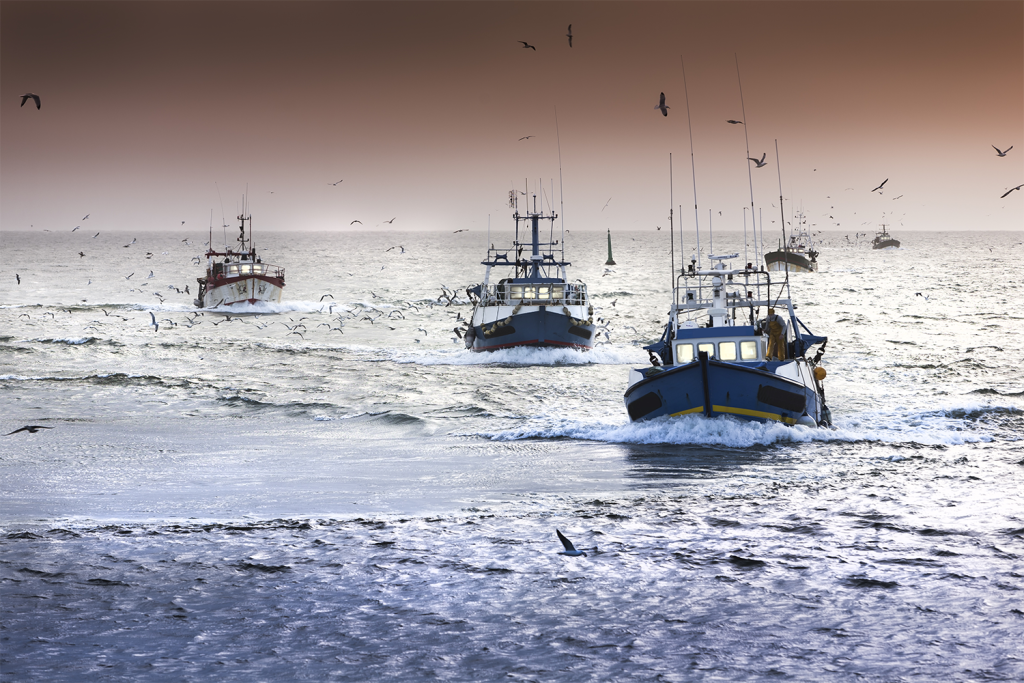
Innovation & Investment
‘We want change’: How a seafood database aims to influence seafood investment decisions
Planet Tracker’s seafood database evaluates seafood companies’ exposure to sustainability risks like overfishing and IUU fishing.
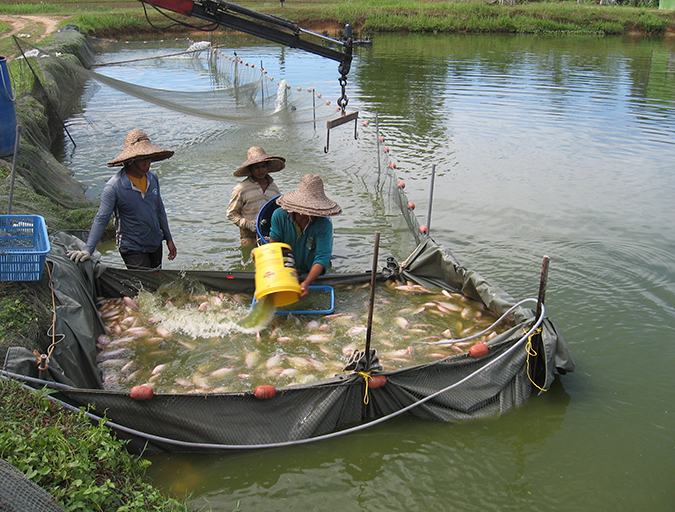
Intelligence
Fisheries and aquaculture: Sister activities with a common goal
Aquaculture and fisheries – although significantly different as one is farming and the other one is hunting – are very closely related activities that share many components of their value chains, including their markets and customers.
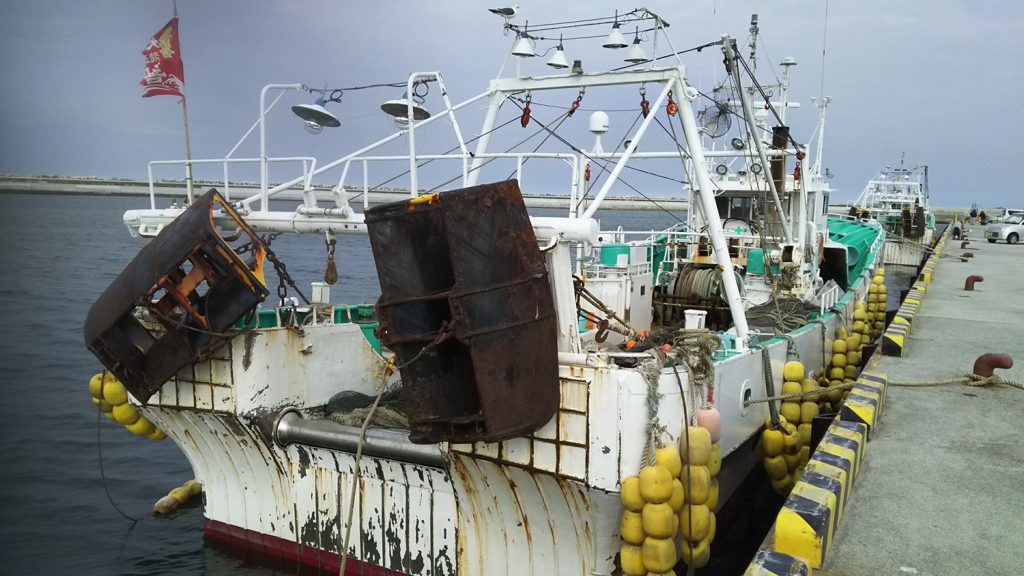
Fisheries
‘It’s been done for decades’ – How the upcoming Fukushima water release could impact Japan’s fishing industry
In Japan, discussions continue and concerns grow as authorities prepare for the Fukushima water release into the Pacific Ocean.



